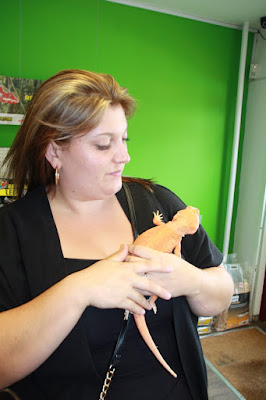Many reptile keepers who don't have UV light try to get round the need for it by dietary supplement of vitamin D or by feeding food that contains vitamin D, such as whole mice and rats. But we still don't know how much UV light most reptiles need. Sometimes a UV light is put into the vivarium and lights up the whole of it so the animal cannot escape exposure to it.
Yet in the wild reptiles regulate their exposure to UV light. In the same way they regulate their body warmth by basking. They will bask inUV as long as they need and then shelter from it. Therefore captive reptiles must be given a hiding place, or the UV light must be applied in such a way that they can move from a "hot" UV spot to a "cooler" UV spot.
Most reptile keepers have caught on to the fact that there must be a temperature gradient within the reptile enclosure, so that the animal can choose whether to be in a hot spot or a cool spot. Now we need to provide them with a UV light gradient too. The heat lamp and the UV lamp should not be combined. A reptile should not have to choose to get too much UV light in order to get heat, or visa versa.
Gary Fergus and colleague decided they would try to work out how much UV light a reptile needed by looking at the animals in the wild and seeing how long they spent exposed to it. It was not easy.
They concluded that keepers of captive reptiles should provide a UV light gradient from maximum to minimum (by providing a refuge). That care should be taken not to produce vitamin D overose by too much supplementary dietary vitamin D.
So far so good. But they highlighted the lack of exact knowledge.
1. How long does each species of reptile in the wild expose itself to UV light?
2. How much vitamin D does the diet of wild reptiles provide?
3. What is the natural circulating level of vitamin D in a wild reptile?
4. How far can the reptile regulate its access to UV light according to its level of vitamin D in the body? ie. does it "know" when its vitamin D levels are low and does it therefore spend more time in UV light?
5. How sensitive is the reptile skin of different species to the absorption of UV light and conversion into vitamin D?
6. What is the ideal level of vitamin D for each species of reptile?
We don't know.
*
Gary W. Ferguson,1 Andrew M. Brinker,1 William H. Gehrmann,1
Stacey E. Bucklin,1 Frances M. Baines,2 and Steve J. Mackin (2010) Voluntary Exposure of Some
Western-Hemisphere Snake and
Lizard Species to Ultraviolet-B
Radiation in the Field: How Much
Ultraviolet-B Should a Lizard or
Snake Receive in Captivity?' Zoo Biology 29, 317-334.





























